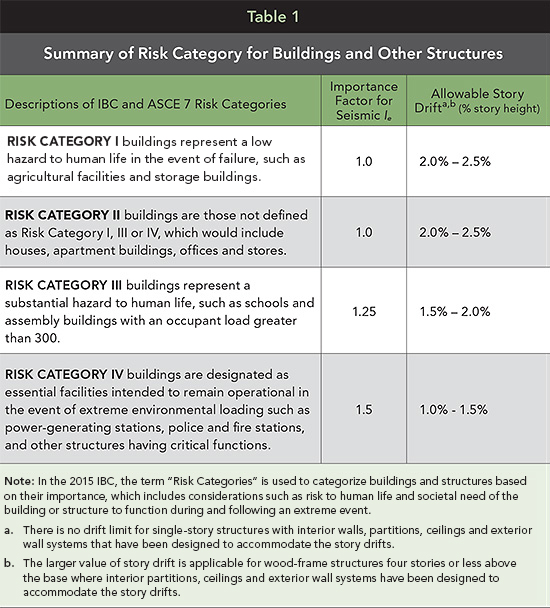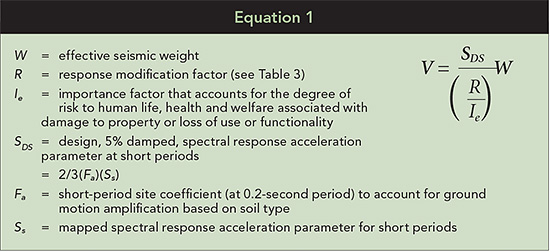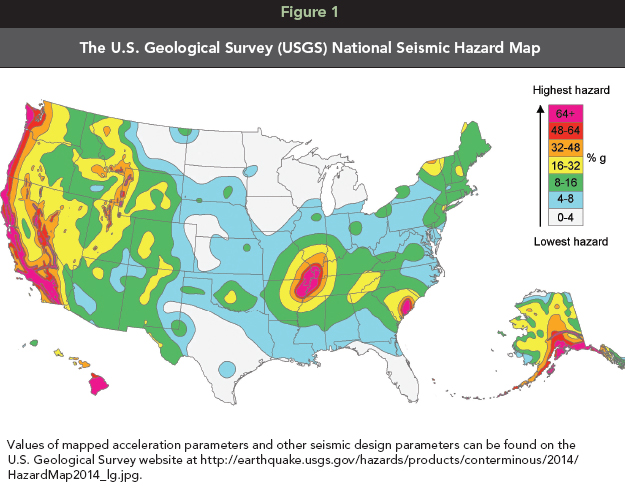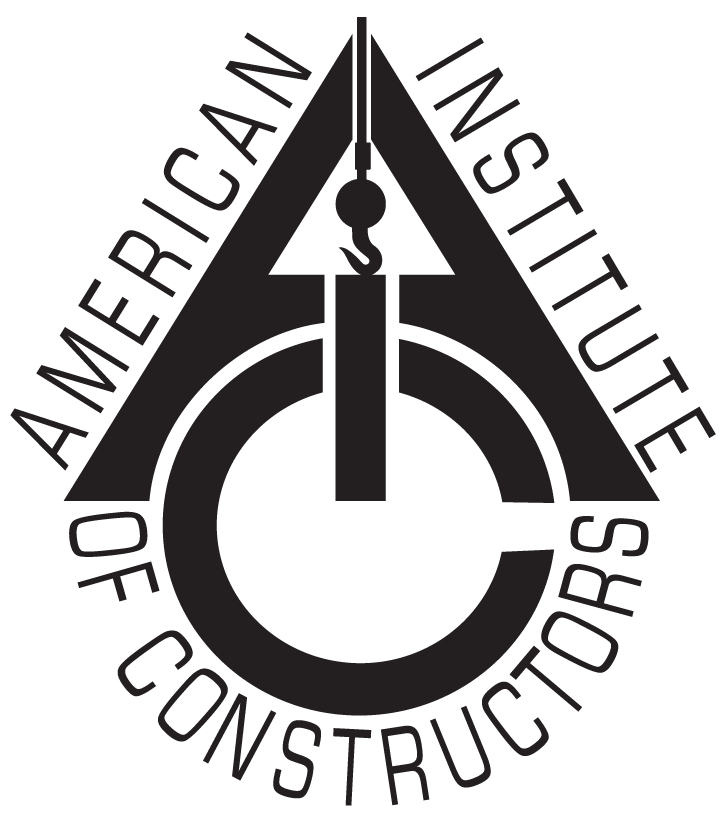Source: U.S. Geological Survey
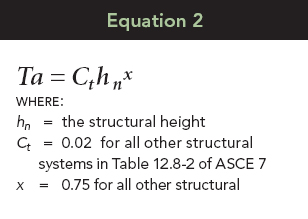

Photo: VanDorpe Chou Associates
Structures with ductile detailing, redundancy and regularity are favored for seismic force
resistance. This structure includes repetitive wood framing and ductile nailed wood structural panel shear walls and diaphragms.

The IBC establishes the minimum lateral seismic design forces for which buildings must be designed primarily by reference to ASCE 7. While ASCE 7 allows use of a number of analysis procedures, the equivalent lateral force (ELF) procedure is most commonly used for seismic design of buildings in the U.S. This is particularly true for low-rise, short-period, wood-frame buildings. The ELF procedure relies on seismic force-resisting system design coefficients such as the response modification coefficient, R (often referred to as the R-factor), deflection amplification factor, Cd, and overstrength factor, Ωo. The R-factor is essential for determining design seismic base shear, V, which is used in the design of elements of the seismic force-resisting system. For short-period, wood-frame structures, seismic base shear, V, is calculated in accordance with Equation 1.
Design seismic base shear is proportional to effective seismic weight, W, the seismic hazard at the site represented by the spectral response acceleration parameter, SDS, response modification coefficient, R, and the importance factor, Ie. Since the R-factor is found in the denominator of the seismic base shear equation, as the R-factor increases for systems being considered, the seismic base shear forces decrease. For wood-frame buildings, values of the R-factor cover a wide range from R=1.5 to R=7.0 depending on the type of wood-frame seismic force-resisting system. (See Table 1.)
For proper design, it is critical to identify the risk category of the building or structure. Detailed descriptions of buildings and structures associated with Risk Category I, II, III and IV are described in IBC Table 1604.5. (For a summary, see Table 1.)
The value of design seismic base shear increases with increasing values of the importance factor, which range from 1.0 for Risk Category I and II structures to a maximum value of 1.5 for Risk Category IV structures. (See Table 1.) The importance factor is equal to 1.25 for Risk Category III structures. Requirements for drift control are also linked to building risk category. Reduced values of permissible drift are associated with higher risk category structures. For example, allowable story drifts range from a maximum of 2.5% of the story height for Risk Category I or II structures to a minimum of 1.0% of the story height for Risk Category IV structures. More stringent drift requirements for higher risk category structures are expected to limit structural and non-structural damage associated with building deformation relative to lower risk category structures.
All except the tallest wood-frame shear wall buildings will be classified as short-period buildings due to the stiffness inherent in wood-frame shear wall structures coupled with the ASCE 7 maximum structural height of 65 ft for wood-frame construction. Within ASCE 7, the applicable equation for determining the approximate fundamental period, Ta, for a wood-frame building is shown in Equation 2.
From Equation 2, values of approximate fundamental period are observed to vary by structural height. The relationship between height and approximate fundamental period is shown in Table 2.
Alternative Simplified Procedure
An alternative simplified version of the ELF procedure is provided in ASCE 7-10 for Risk Category I or II buildings three stories or less in height, including building configuration limits to avoid a significant torsional response. The simplified procedure is not applicable in Site Class E or F (e.g., soft clay soils, peats and/or highly organic clays, very high plasticity clays, and very thick soft/medium stiff clays). The design base shear is roughly equivalent to that derived from the full ELF procedure for one-story structures, but results in a slightly more conservative first-story design base shear in multi-story structures. Features of the simplified procedure are: 1) a simplified story shear distribution assumption—e.g., story shear is taken as proportional to the effective seismic weight at each level, 2) omission of requirements to check story drift, and 3) use of seismic R-factors associated with the full ELF procedure.
Wood-Frame Seismic Force-Resisting Systems
Specific wood-frame seismic force-resisting systems recognized in ASCE 7 are listed in Table 3. In accordance with ASCE 7, each seismic force-resisting system is associated with seismic design coefficients (R, Cd and Ωo) and height limitations based on seismic design category (SDC). For wood-frame seismic force-resisting systems, listed seismic design coefficients are applicable for systems designed in accordance with the SDPWS for wood-frame shear walls and diaphragms and with the NDS for wood member and connection design. In typical wood-frame platform construction, the bearing wall system category is generally applicable because shear walls used for seismic force resistance also function to support gravity loads of the building. While slightly larger R-factors are associated with shear walls in building frame systems in which gravity loads are carried by a separate structural system (such as a structural frame of beams and columns) and the shear walls resist seismic shear loading only, this type of structural system is less prevalent than standard platform construction. The slight increase in R-factor recognized for building frame systems is based largely on the judgment that the shear walls providing shear resistance in such systems are less susceptible to strength and stiffness degradation from combined gravity and seismic shear loading than shear walls in bearing wall systems.
As defined in ASCE 7-10, the most common seismic force-resisting systems employed in wood-frame platform construction are A15 and A17. The design requirements and construction details for wood-frame shear walls used in those systems for seismic force resistance are contained in the SDPWS. Specific details for each system include the following:
SDPWS 4.3: Wood-frame wood structural panel shear walls (applicable for bearing wall system A15 and building frame system B22 per ASCE 7-10)
▶ This system includes wood structural panels conforming to the requirements of the U.S. Department of Commerce/National Institute of Standards and Technology documents, PS 1-09 Structural Plywood or PS 2-10 Performance Standard for Wood-Based Structural-Use Panels.
▶ All framing members and blocking are 2-in. nominal or greater except that 3-in. nominal or greater framing is used at adjoining panel edges for closely spaced nails, larger-diameter nails or higher-strength shear walls.
▶ Nails are located at least 3/8 in. from panel edges and fastener spacing at panel edges is not less than 2 in. on center (o.c.).
▶ Foundation anchor bolts have a steel plate washer under each nut not less than 0.229 in. x 3 in. x 3 in. in size except where standard cut washers are explicitly permitted.
▶ Design for shear and overturning provides for properly sized tension and compression chords and shear and overturning anchorage.
▶ Maximum shear wall aspect ratio (e.g., height-to-length ratio) is 3.5:1.
▶ Allowable unit shear strengths range from 200 plf (3/8-in. rated sheathing on one side, 6d common nails and 6 in. o.c. nail spacing at panel edges) to 1,740 plf (19/32-in. rated sheathing on two sides, 10d common nails and 2 in. o.c. nail spacing at panel edges).
▶ This system is permitted in seismic design categories A, B, C, D, E and F.
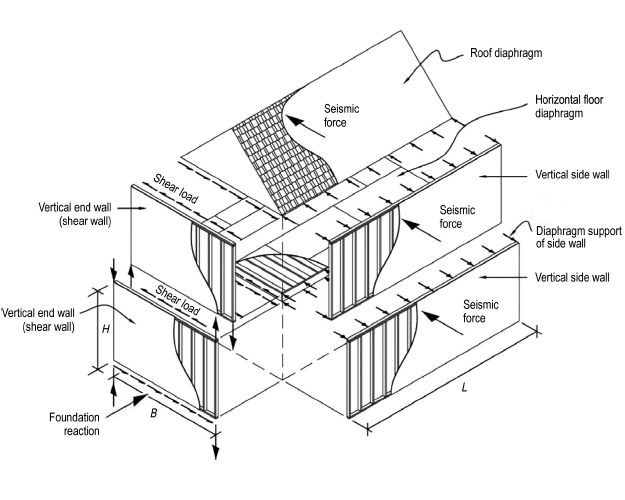
Source: FEMA (2006). Homebuilders’ guide to earthquake-resistant design and construction, FEMA 232, Federal Emergency Management Agency, Washington, D.C.
LOAD PATH IN LIGHT-FRAME WOOD BUILDING
This Figure illustrates the load paths for resistance to seismic forces. When structural panels such as plywood or oriented strand board (OSB) are properly attached to lumber floor, roof and wall framing, they form diaphragms and shear walls that are exceptional at resisting these forces.
SDPWS 4.3: Wood-frame shear walls sheathed with other materials (applicable for bearing wall systems A17 and building frame system B24 per ASCE 7-10)
▶ This system includes shear panels of particleboard, structural fiberboard, gypsum wallboard, gypsum base for veneer plaster, water-resistant gypsum backing board, gypsum sheathing board, gypsum lath and plaster, and Portland cement plaster, or lumber sheathing with fastening and shear wall aspect ratio varying by shear panel type.
▶ All framing members and blocking used for shear wall construction are 2-in. nominal or greater.
▶ Foundation anchor bolts have a steel plate washer under each nut not less than 0.229 in. x 3 in. x 3 in. in size except in some cases where standard cut washers are explicitly permitted.
▶ Design for shear and overturning provides for properly sized tension and compression chords and shear and overturning anchorage.
▶ Allowable unit shear strengths span a wide range across different sheathing materials. For 1/2-in. gypsum wallboard, allowable unit shear strengths range from 75 plf (sheathed on one side, unblocked panel edges, and 7-in. fastener spacing at panel edges) to 360 plf (sheathed on two sides, blocked panel edges, and 4-in. fastener spacing at panel edges). Particleboard, structural fiberboard, horizontal lumber and vertical board shear walls are permitted in seismic design categories A, B and C.
▶ Gypsum wallboard, gypsum base for veneer plaster, water-resistant gypsum backing board, gypsum sheathing board, gypsum lath and plaster, or Portland cement plaster, and diagonal lumber shear walls are permitted in seismic design categories A, B, C and D.
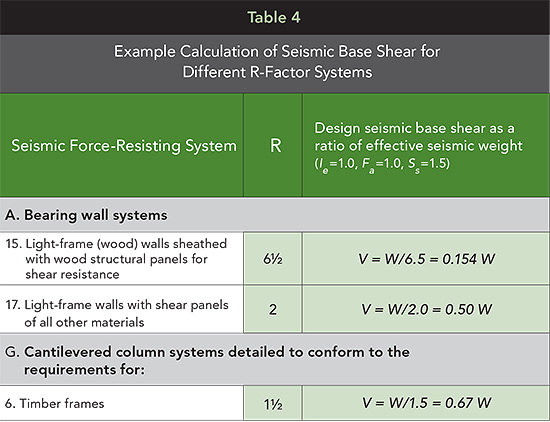
Wood-frame wood structural panel shear walls are prevalent in high seismic areas where lateral forces from seismic loading control the required length of shear walls. Relatively large design strengths and permitted use of up to 3.5:1 aspect ratio wood structural panel shear walls provide design flexibility to accommodate building configurations where total length of wall or aspect ratio of wall portions available for seismic force resistance is limited. Additionally, wood-frame wood structural panel shear walls are permitted for use in all SDCs and, in SDC D, E and F, are permitted with structural height of 65 ft. In contrast, wood-frame shear walls sheathed with other materials are generally associated with smaller values of design strength, most commonly used where large lengths of shear wall are available, not permitted in SDC E and F, and limited to a structural height of 35 ft in SDC D. In some cases, such as for structural fiberboard shear walls and particleboard shear walls, use of such shear walls for seismic force resistance is limited to SDC A, B and C only with a structural height of 35 ft in SDC C.
For inverted pendulum structures of timber frames (e.g., system G6. Timber Frames), seismic design coefficients (R=1.5, Ωo=1.5, and Cd=1.5) are applicable. Such systems include wood pile-supported structures where the wood member and its connections are designed in accordance with member and connection provisions of the NDS.
Seismic Design Category
The seismic design category for the structure at the site is critical for proper application of requirements for seismic design. The SDC is used as a trigger for permitted use of seismic systems and structural height limitations as seen in Table 3. It is also used to trigger applicability of special requirements associated with structural redundancy and structural irregularities in the building system. SDC is determined based on several factors:
▶ Soil properties at the site, or site class, which range through site class A, B, C, D, E and F. Site class A is associated with presence of hard rock. Site class F is associated with peats and/or highly organic clays, very high plasticity clays and very thick soft/medium stiff clays.
▶ Mapped values of seismic hazard
▶ Risk category of the structure
For short-period structures, such as most wood-frame structures, ASCE 7 allows determination of the seismic design category based on value of SDS and risk category alone (see Table 5) provided alternative criteria are met for structure period and diaphragm flexibility and for sites where mapped values of S1 are less than 0.75. Seismic design categories A, B, C, D, E and F reflect the range of possible categories under ASCE 7. They are similar to seismic zones found in previous codes; however, seismic design categories are more representative of the risk to a particular building because they incorporate the structure’s risk category, site conditions and mapped seismic hazard at the site.
SDC A represents a very low seismic hazard for which there are no seismic-specific limits on structural height, system type, structural redundancy or structural irregularities. Structures located in this category are not subject to design forces determined in accordance with the ELF. Beginning with SDC B, seismic forces in accordance with ELF are applicable and consideration must be given to special requirements for structural irregularities. Special requirements and limitations become increasingly significant beginning in SDC C. As can be seen in Table 3, as seismic design category increases, structural height limitations apply as well as limitations on the use of particular systems.
Structural Redundancy
The arrangement of structural elements within the building structure is recognized as significant to seismic performance. Buildings with a high degree of redundancy tend to perform better than those where structural resistance is concentrated in just a few elements. The goal of redundancy requirements in the code is to encourage redundant layouts of seismic force-resisting system elements. The redundancy factor, ρ, varies from 1.0 to 1.3 and has different criteria based on judgment applied to the various system configurations. The redundancy factor equals 1.0 in SDC B and C. For wood-frame shear walls in higher seismic design categories, use of a redundancy factor equal to 1.0 can often be accomplished for plans that have a regular layout and resistance provided at building perimeters, where aspect ratio (height-to-length ratio) of shear walls providing shear resistance is 1.0 or less, or, for cases where aspect ratio of shear walls is greater than 1.0, the minimum length of wood structural panel shear wall equals or exceeds the story height.

Photo: Dreamstime
When structural panels such as plywood or oriented strand board (OSB) are properly attached to lumber floor, roof and wall framing, they form diaphragms and shear walls that are exceptional at resisting seismic forces.
Structural Irregularities
Structural irregularities are formed when the load path for strength or stiffness of a structure is interrupted thus concentrating demand on certain elements of the structure. Structural irregularities have been observed in prior earthquakes to cause a variety of problems that can range in seriousness from localized failure to an undesirable overall response causing total collapse. Irregularities are categorized in two groups: horizontal and vertical. Horizontal structural irregularities include: torsional irregularity, re-entrant corner irregularity, diaphragm discontinuity irregularity, out-of-plane offset irregularity and nonparallel system irregularity. Vertical structural irregularities include: soft story irregularity, weight irregularity, vertical geometric irregularity, in-plane discontinuity irregularity and discontinuity in lateral strength irregularity (e.g., weak story). Examples of common irregularities are shown in Figure 2.
Buildings with Combinations of Framing Systems
Buildings typically have only one structural system and associated R-factor in each principal axis and vertically. However, in cases where more than one R-factor system is utilized horizontally or vertically, special rules of ASCE 7 apply. In general, design forces and limitations associated with the lower R-factor system are applicable for design in the direction of each principal axis under consideration. There are three common exceptions worthy of mention.
Vertical combinations: Where a building transitions from one system to another vertically through the height of the building structure, system height limits are imposed for the entire structure based on the most restrictive system used. When the upper portion of the structure has a larger R-factor, the upper portion is permitted to be designed for the R-factor associated with that system. The forces imposed from the upper portion onto the lower portion are required to be multiplied (increased) by the ratio of R-factors.
Horizontal combinations: For one- or two-story Risk Category I or II buildings of light-frame or flexible diaphragm construction, the lowest R-factor in any independent line of resistance may be utilized as long as the diaphragm is designed for the lowest R-factor in the overall direction.
Two-stage analysis procedure: This procedure applies when the upper portion of a structure is relatively flexible compared to a rigid lower portion. In this case, the interface between the upper and lower portions is considered to be the base of the upper structure from which structural height of the upper portion is measured. For these structures, the overall building height equals the structural height for the upper portion added to the height of the lower portion. The most common application of the two-stage analysis procedure for wood-frame construction utilizes an upper portion constructed of wood-frame wood structural panel shear walls (structural height limited to 65 ft maximum above the top of the lower portion in SDC D, E, and F) constructed on top of a Type IA concrete podium.
Several requirements must be met in order to comply with requirements of the two-stage analysis procedure:
▶ The lower structure must be at least 10 times as stiff as the upper structure.
▶ The period of the entire structure shall not be greater than 1.1 times the period of the upper portion considered as a separate structure supported at the transition from the upper to the lower portion.
▶ The upper portion shall be designed as a separate structure using the appropriate values of R and ρ.
▶ The lower portion shall be designed as a separate structure using the appropriate values of R and ρ. The reactions from the upper portion shall be those determined from the analysis of the upper portion amplified by the ratio of the R/ρ of the upper portion over R/ρ of the lower portion. This ratio shall not be less than 1.0.
▶ The upper portion is analyzed with the equivalent lateral force or modal response spectrum procedure, and the lower portion is analyzed with the equivalent lateral force procedure.
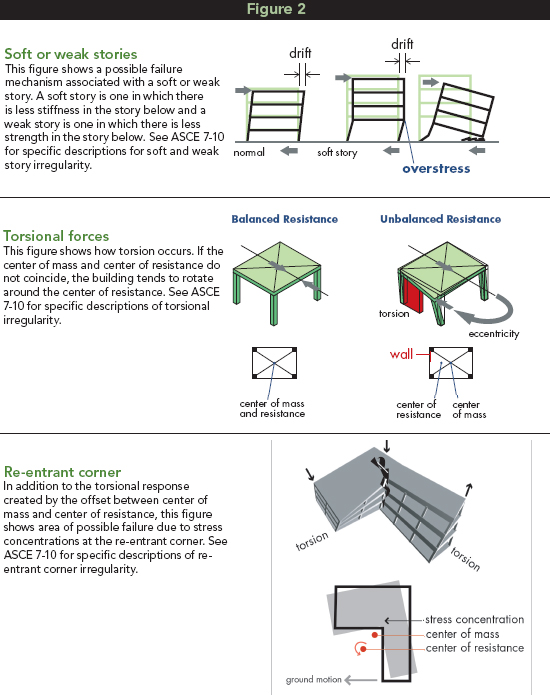
Source: FEMA
Examples of structural irregularities from FEMA 424 – Design Guide for Improving School Safety in Earthquakes, Floods and High Winds. Another good reference is FEMA 454 – Designing for Earthquakes – a Manual for Architects.
In SDC D, E, and F, the two-stage procedure can be used over a 20-ft-high Type IA podium allowing the overall building construction height of up to 85 ft maximum prescribed in the height and area provisions of the IBC. In addition, to allow the design to structurally achieve height limits associated with height and area provisions, the two-stage procedure allows the upper portion to have the maximum permitted number of stories and area while being considered a separate structure for IBC height and area purposes (with the overall building height measured from the ground).
Nonstructural Component Bracing
Higher performance for critical and essential facilities is accomplished, in part, by designing for higher forces associated with application of the Risk Category Importance Factor and more stringent drift criteria (mentioned previously). It is also achieved through requirements for bracing of nonstructural components within the building. Examples include bracing of fire sprinkler lines, gas supply lines, critical equipment, egress stairways and any other component needed for continued operation of a Risk Category IV structure. While requirements for bracing of nonstructural components are the most extensive for Risk Category IV buildings, they are also applicable in varying degrees to other structures based on factors such as seismic design category, structure type and weight, and importance factor assigned to the component.
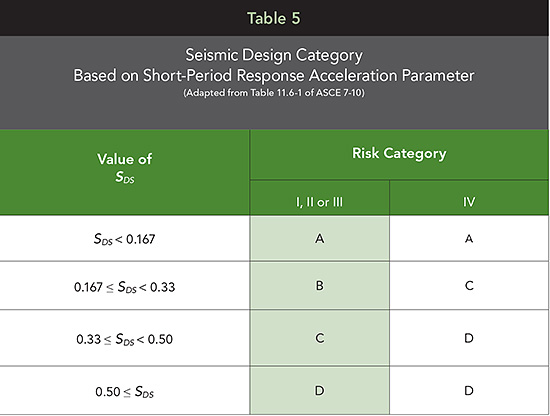
Source: FEMA
Examples of structural irregularities from FEMA 424 – Design Guide for Improving School Safety in Earthquakes, Floods and High Winds. Another good reference is FEMA 454 – Designing for Earthquakes – a Manual for Architects.
Conclusion
Years of research and building code development have proven that wood-frame buildings can be designed to meet or exceed the most demanding earthquake requirements. As discussed in this course, wood buildings offer a number of advantages that contribute to their relative good performance in seismic events. Among other things, they tend to be lightweight, reducing seismic forces (which are proportional to weight). Multiple nailed connections in framing members, shear walls and diaphragms offer ductility, meaning they have the ability to yield and displace without sudden brittle fracture. Repetitive members and multiple connections create redundant load paths, which effectively transfer lateral loads. And, when structural panels such as plywood or oriented strand board are properly attached to lumber floor, roof and wall framing, the resulting diaphragms and shear walls offer exceptional seismic force resistance.
For more detailed information on the subjects covered in this CEU, a new version of the American Wood Council’s Code Conforming Wood Design based on the 2018 CCWD is available as a free download at www.awc.org
Endnotes
- U.S. Geological Survey,
earthquake.usgs.gov/earthquakes/search/
- U.S. Geological Survey,
earthquake.usgs.gov/earthquakes/?source=sitenav
- The January 17, 1994 Northridge, CA Earthquake An EQE Summary Report, March 1994,
lafire.com/famous_fires/1994-0117_NorthridgeEarthquake/quake/00_EQE_contents.htm
- Seismic Design with Wood: Solutions for British Columbia Schools. WoodWorks!, 2016,
wood-works.ca/wp-content/uploads/2016-WW.Seismic.final_.LR_.05.05.16.pdf
- Seismic Safety Inventory of California Public Schools, California Department of Government Services, 2002,
www.bestfacilities.org/best-home/docuploads/pub/108_SeismicSafetyInventory_CA.pdf
- Wood-frame construction in past earthquakes, Rainer, J. Hans, Karacabeyli, E., FPInnovations,
www.iitk.ac.in/nicee/wcee/article/2454.pdf
 |
Think Wood is a leading education provider on the advantages of using softwood lumber in commercial, community and multifamily building applications. We introduce innovators in the field to our community of architects, engineers, designers and developers. For support or resources, contact us at info@ThinkWood.com.
|






